Temple Bruer |
Dunston Pillar - Francis Dashwood -Hell Fire Club |
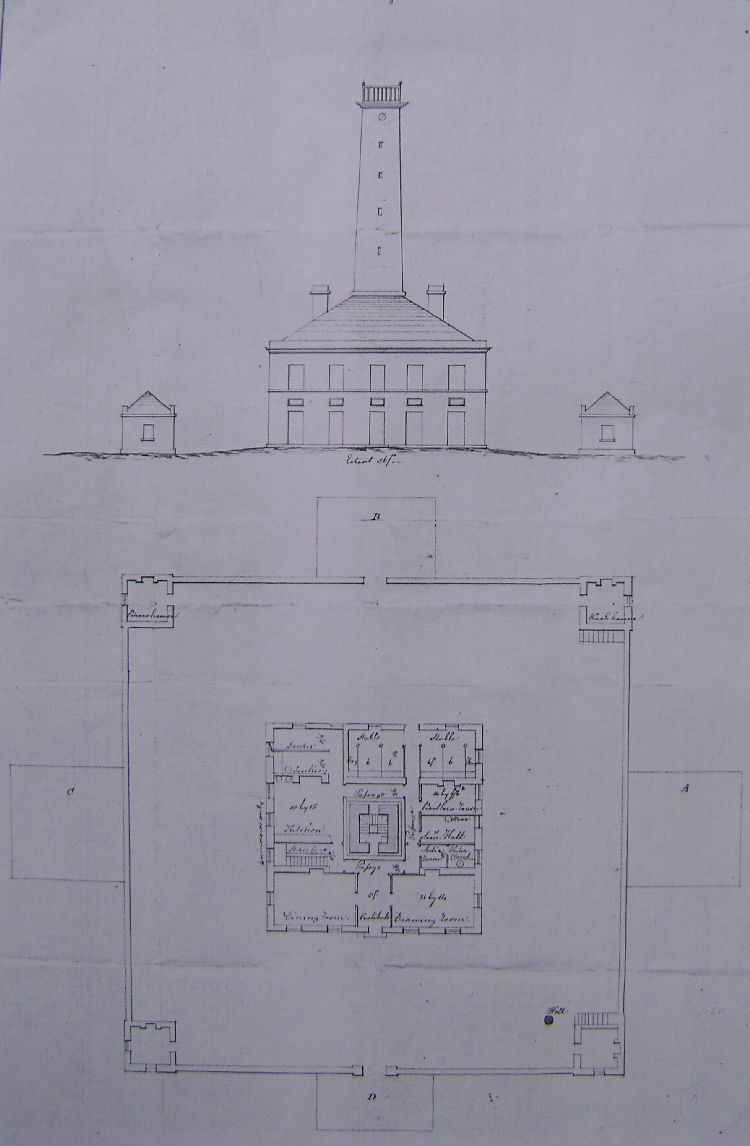 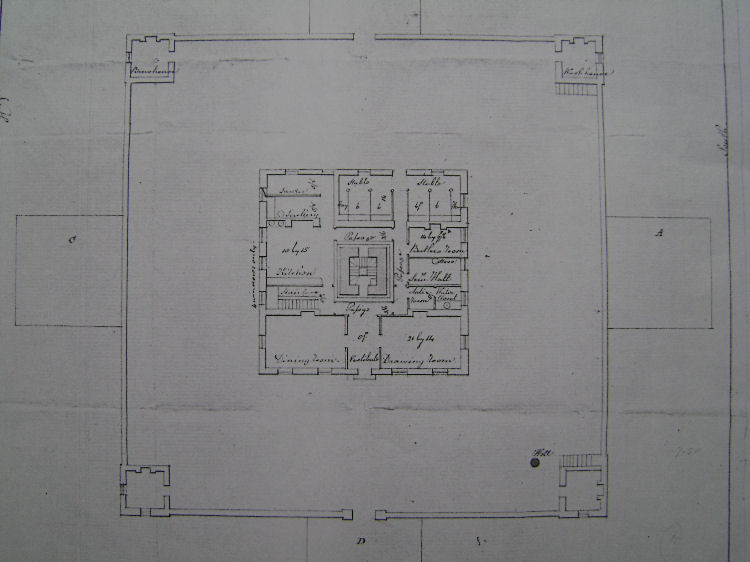 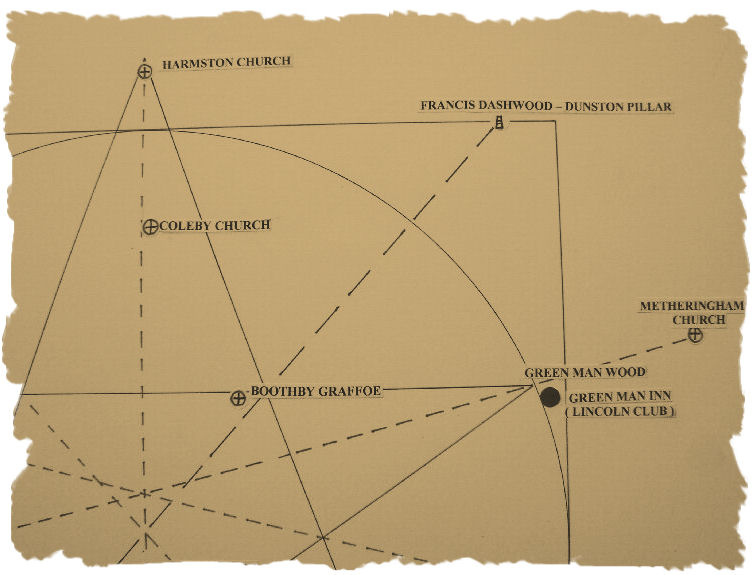 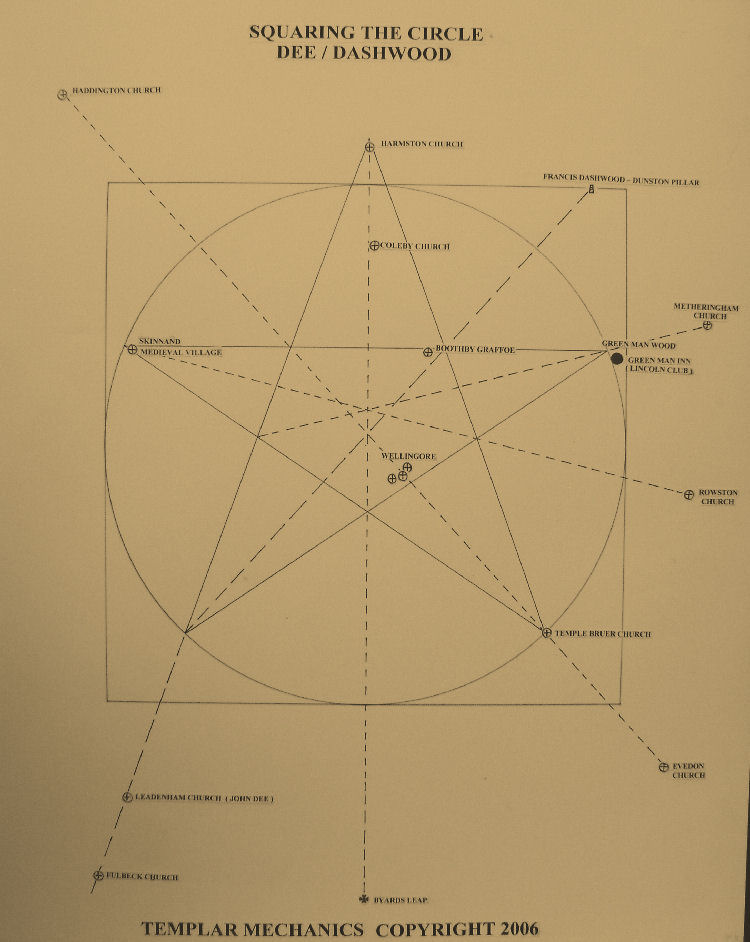 Geometry OS 272 1:25000
This is the only interacting geometry I have found relating to the inland lighthouse built by the occultist and Hell Fire Club creator , Sir Francis Dashwood who lived at Nocton Hall, just to the east of Dunston Pillar.UPDATE FEB 2/2008 - More Geometry - Dashwoods lighthouse is positioned on the line if the main circle is squared. Geometry OS 272 1:25000
This is the only interacting geometry I have found relating to the inland lighthouse built by the occultist and Hell Fire Club creator , Sir Francis Dashwood who lived at Nocton Hall, just to the east of Dunston Pillar.UPDATE FEB 2/2008 - More Geometry - Dashwoods lighthouse is positioned on the line if the main circle is squared. 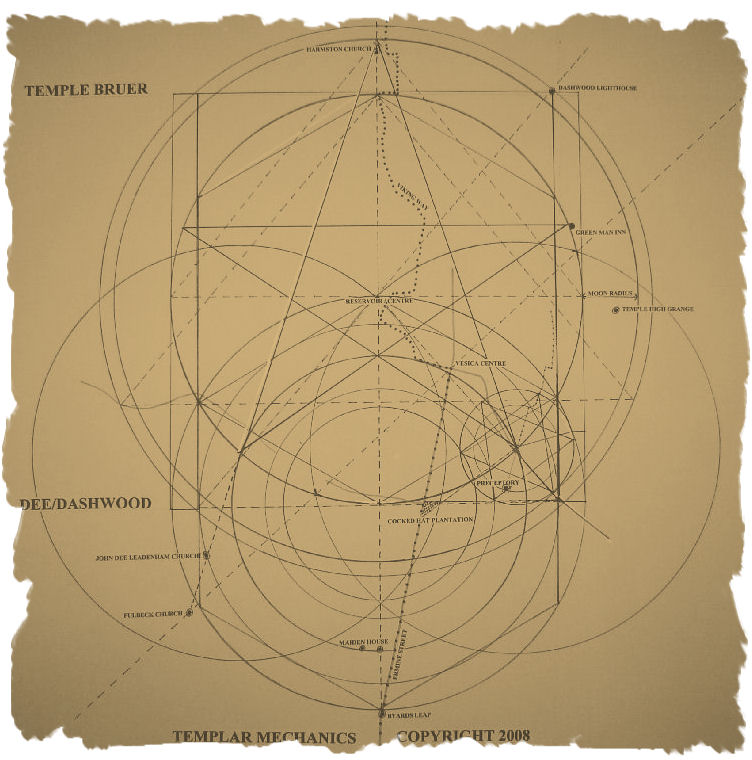 . In fact today held a surprise for me as I discovered another church not on the current OS maps…..it seems fate delivered to my mental inbox just what I needed at just the right time, to complete this article.
The first line discovered splits the pentacle leg perfectly , exits through the pentacle shoulder junction and onto Dunston Pillar.
Once I found this I wondered where the other equal pentacle leg /arm divisions would lead, if drawn in/followed through. This led to the next revelation…..all the lines went to significant places/churches, listed below and can be seen on the diagram…TB 7.
Metheringham chapel
Rowston church
Evedon Church
Haddington Church
Byards Leap – Templar connections
The most interesting of these is the Harmston to Byards leap, which incidentally has templar connections. This line points magnetic north and runs the length of the pentacle body starting at Harmston , exiting at the base point and onto Byards Leap.
Harmston Church , top of the pentacle is once again a major player in the new geometry….its now involved at 4 levels, and if it had been placed anywhere else it would throw out of line the other the geometry of :
1.The pentacle
2.The 18 churches
3.The Seal of Solomon
4.The Dunston Pillar
And also the whole pentacle’s alignment to magnetic north…..how odd.
The RED line from the left leg to Dunston Pillar can then be followed through to the top of the pentacle at Harmston Church and onto Aubourn Church.
The return line from Aubourn church to the original bottom pentacle leg , sees it brushing the right arm of the pentacle.
This I pondered this for a while…I became curious as to why it didn’t hit the right pentacle arm at the point?
But as fate would have it, I was given the answer.
Earlier today I met the Temple Bruer caretaker , a lovely lady called Rita who by coincidence had an older map of the Bruer area in the village school attached to the church …The map showed a church not shown on the later maps at the old medieval village of Skinnand, the remains of which sits just slightly to the S.E of the pentacles right arm.
This is the area where the return line hits….. ;-)
Please find below an interesting article compiled from the MACLA site, along with pictures of Dunston Pillar.
In the mid 18th century the area where this stone tower stands was very much a bleak heathland and as yet had not been farmed. Running through it was what is now known as the A15 but back in time this was the “Ermine Street” the Saxon name for one of the four most important Roman roads ever built in England, running from London to Lincoln and York. Despite this it was then only a rough track and for travellers passing across these barren lands, they did so in trepidation of being attacked by highwaymen.
The local landowner at this time was a Sir Francis Dashwood (1708-1781), better known as a founder member of the infamous “Hellfire Club” based at Medmenham Abbey near the River Thames in London (a club which allegedly organised orgiastic and satanical ceremonies where masks and costumes were worn to allow them to indulge in varying degrees of debauchery). Other members of this club included the then Prince of Wales and John Manners the Marquis of Granby!). Dashwood, although originating from West Wycombe, Bucks, had a home at Nocton Hall and thus owned the land around and up to the western boundaries of the Nocton and Dunston Heath. . In fact today held a surprise for me as I discovered another church not on the current OS maps…..it seems fate delivered to my mental inbox just what I needed at just the right time, to complete this article.
The first line discovered splits the pentacle leg perfectly , exits through the pentacle shoulder junction and onto Dunston Pillar.
Once I found this I wondered where the other equal pentacle leg /arm divisions would lead, if drawn in/followed through. This led to the next revelation…..all the lines went to significant places/churches, listed below and can be seen on the diagram…TB 7.
Metheringham chapel
Rowston church
Evedon Church
Haddington Church
Byards Leap – Templar connections
The most interesting of these is the Harmston to Byards leap, which incidentally has templar connections. This line points magnetic north and runs the length of the pentacle body starting at Harmston , exiting at the base point and onto Byards Leap.
Harmston Church , top of the pentacle is once again a major player in the new geometry….its now involved at 4 levels, and if it had been placed anywhere else it would throw out of line the other the geometry of :
1.The pentacle
2.The 18 churches
3.The Seal of Solomon
4.The Dunston Pillar
And also the whole pentacle’s alignment to magnetic north…..how odd.
The RED line from the left leg to Dunston Pillar can then be followed through to the top of the pentacle at Harmston Church and onto Aubourn Church.
The return line from Aubourn church to the original bottom pentacle leg , sees it brushing the right arm of the pentacle.
This I pondered this for a while…I became curious as to why it didn’t hit the right pentacle arm at the point?
But as fate would have it, I was given the answer.
Earlier today I met the Temple Bruer caretaker , a lovely lady called Rita who by coincidence had an older map of the Bruer area in the village school attached to the church …The map showed a church not shown on the later maps at the old medieval village of Skinnand, the remains of which sits just slightly to the S.E of the pentacles right arm.
This is the area where the return line hits….. ;-)
Please find below an interesting article compiled from the MACLA site, along with pictures of Dunston Pillar.
In the mid 18th century the area where this stone tower stands was very much a bleak heathland and as yet had not been farmed. Running through it was what is now known as the A15 but back in time this was the “Ermine Street” the Saxon name for one of the four most important Roman roads ever built in England, running from London to Lincoln and York. Despite this it was then only a rough track and for travellers passing across these barren lands, they did so in trepidation of being attacked by highwaymen.
The local landowner at this time was a Sir Francis Dashwood (1708-1781), better known as a founder member of the infamous “Hellfire Club” based at Medmenham Abbey near the River Thames in London (a club which allegedly organised orgiastic and satanical ceremonies where masks and costumes were worn to allow them to indulge in varying degrees of debauchery). Other members of this club included the then Prince of Wales and John Manners the Marquis of Granby!). Dashwood, although originating from West Wycombe, Bucks, had a home at Nocton Hall and thus owned the land around and up to the western boundaries of the Nocton and Dunston Heath.
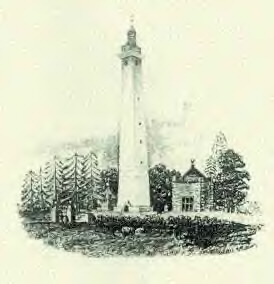 Using a similar design to the centre cupola (dome) in his home at Nocton the Pillar was built in 1751. It rose some 28 metres (92 feet) and then on top of this was a 4.5 metre (15 feet) high octagonal lantern. Originally there was a spiral staircase inside the Pillar to take the “Lighthouse Keeper” to the balustrade gallery which surrounded the base of the lantern. The view from this superb construction was truly amazing. To the north one could clearly see Lincoln Cathedral and far to the south east one could (on a clear day) see Boston Stump.
.
.
Using a similar design to the centre cupola (dome) in his home at Nocton the Pillar was built in 1751. It rose some 28 metres (92 feet) and then on top of this was a 4.5 metre (15 feet) high octagonal lantern. Originally there was a spiral staircase inside the Pillar to take the “Lighthouse Keeper” to the balustrade gallery which surrounded the base of the lantern. The view from this superb construction was truly amazing. To the north one could clearly see Lincoln Cathedral and far to the south east one could (on a clear day) see Boston Stump.
.
.
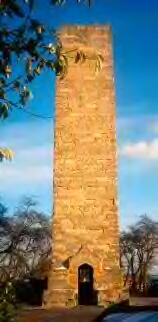 The Pillar which was in actual fact in Nocton Parish became known locally as Dunston Pillar and proved to be an early “tourist attraction” where travellers could rest, passing the time in the assembly rooms and bowling green adjacent.
Dashwood had inscriptions engraved on the sides of the Pillar. On the east side (Dunston Pillar). on the North (To Lincoln V miles). on the south side (from the City CXX miles) (i.e. the distance to London) and on the west side (Columnam Hane Utilitate Publicae, DDD F Dashwood, MDCCLI).
Every night the lantern was lit and this continued until 1788 when the “heathland” became more “user friendly” and better roads were constructed.
The Pillar which was in actual fact in Nocton Parish became known locally as Dunston Pillar and proved to be an early “tourist attraction” where travellers could rest, passing the time in the assembly rooms and bowling green adjacent.
Dashwood had inscriptions engraved on the sides of the Pillar. On the east side (Dunston Pillar). on the North (To Lincoln V miles). on the south side (from the City CXX miles) (i.e. the distance to London) and on the west side (Columnam Hane Utilitate Publicae, DDD F Dashwood, MDCCLI).
Every night the lantern was lit and this continued until 1788 when the “heathland” became more “user friendly” and better roads were constructed.
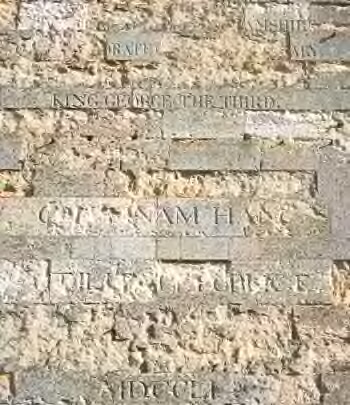 In time, the heath was tamed, becoming good arable land. The lantern gradually collapsed as the ironwork rusted and, in 1808, the lantern was replaced with a bust of King George III by the Earl of Buckinghamshire to celebrate 50 years of the king's reign.
In time, the heath was tamed, becoming good arable land. The lantern gradually collapsed as the ironwork rusted and, in 1808, the lantern was replaced with a bust of King George III by the Earl of Buckinghamshire to celebrate 50 years of the king's reign.
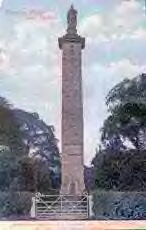 The Earl of Buckinghamshire (1760-1816) who had taken ownership of the land, replaced the lantern with a 15 foot high (4.5 metres) statue of the King George III, dressed in the robes of the Order of the Garter. It was erected to celebrate the Golden Jubilee of the King.
The statue was built of a unique material called Coade Stone (invented in 1769 by Eleanor Coade (1733-1821)) which was a moulded artificial stone material with a hard surface finish (like a ceramic) that had to be subjected to a vast amount of heat for several days in a kiln. The crude firing methods of those times suggested that the skills and results of Eleanor Coade were really remarkable. The pre-moulded statue itself was hollow inside and held together with iron bolts encased in lead to prevent rust from affecting the stone.
The Earl of Buckinghamshire (1760-1816) who had taken ownership of the land, replaced the lantern with a 15 foot high (4.5 metres) statue of the King George III, dressed in the robes of the Order of the Garter. It was erected to celebrate the Golden Jubilee of the King.
The statue was built of a unique material called Coade Stone (invented in 1769 by Eleanor Coade (1733-1821)) which was a moulded artificial stone material with a hard surface finish (like a ceramic) that had to be subjected to a vast amount of heat for several days in a kiln. The crude firing methods of those times suggested that the skills and results of Eleanor Coade were really remarkable. The pre-moulded statue itself was hollow inside and held together with iron bolts encased in lead to prevent rust from affecting the stone.
A local Harmston man John Willson was involved in the fixing of the statue to the top of the Pillar. Unfortunately he fell the 92 feet (28 m) to his death (aged 56) on 9th September 1810 and he is now buried in Harmston graveyard with his gravestone featuring a relief carving of the Pillar and the inscription in both English and Latin “ He who erected the noble King, here now laid by Deaths sharp sting” and “Qui erexit nobilem Regem, Nune hic jacet per Mortis legen” For the next 130 years until 1941, George III stood proudly above the Lincolnshire countryside until it was considered a hazard to low flying aircraft using the RAF stations at Waddington and Coleby Grange during World War II. It was decided the statue had to go and there are suggestions that the removal of it was by block and tackle but one has to assume that George was possibly more unceremoniously pushed from his perch as much of the 4.5 metre figure was broken into numerous fragments.Fortunately those responsible had the common sense to place much of the pieces into storage and a good percentage of it is now held by the Lincolnshire County Council in the cellars of the old prison in Lincoln Castle where they can be viewed today. Not only was the statue removed but the pillar too was reduced by some 60 feet (18.3 m) to the height it stands today of just 30 feet (9.15 m) In recent times the head and shoulders of George were reconstructed by a local monumental mason, John Ivory. Despite 130 years exposure to the elements on Nocton Heath there were no traces of weathering and in 1973 it was put on display in the grounds of Lincoln Castle where it stands now. In 1991 Dunston village community had a wooden replica of the statue and pillar commissioned and this can be seen in the grounds of their Village Hall. The Heritage Trust of Lincolnshire, under their Director David Start, would dearly like to see the original, full-length statue of George re-built to its former glory and surveys have been carried out to see what the practicalities are. How much such a project would cost and whether Heritage Lottery funding could be secured are some of the questions that still need answering but a figure in the region of £300,000 has been suggested. Also to be considered is where best should such re-constructed statue be placed. In all honesty there is only one place, and that is back on the top of Dunston Pillar but that would depend on the approval of several authorities and various other issues. Some monies have been promised already but what is needed to secure any sort of Lottery funding is a demonstration of support and backing from the people of Lincolnshire. Anyone willing to give this support are asked to write a brief letter to :The Director of Heritage Trust for Lincolnshire, The Old School, Cameron Street, Heckington, Sleaford, NG34 9RW. Furthermore if anyone wants to know more or can offer any information which might be useful can contact David Start on 01529 461499 NB. The highest local buildings: St James Church spire at Louth is 295 feet high (89.9m) St Wulfram’s Church spire at Grantham is 282 feet high (85.95m) Boston Stump stands 272 feet (82.9) Lincoln Cathedral’s highest tower is 270 feet (82.3m) (until a storm in1548 it had the highest spire in Europe at 524 feet)(159.7m) Nelson’s Column in London stands 165 feet high (50.29m) Thanks to MACLA for allowing Templar Mechanics to post the article.. |
|
This site is © 2008-2011 Templar Mechanics. All rights reserved. Materials must not be reproduced without prior consent of Templar Mechanics. Any unauthorised reproduction or copying of its content will result in legal action being taken. |
For all enquiries, please e-mail enquiries@templarmechanics.com |